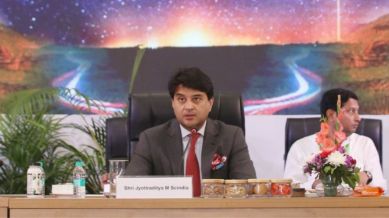‘Open to help those that missed targets’: MoC Scindia on Telecom PLI scheme beneficiaries
Speaking at a press conference, Union Minister of Communications Jyotiraditya Scindia also highlighted telecom and digital inclusion as key drivers of India’s economic growth.

The central government’s production-linked incentive (PLI) scheme for manufacturing telecom equipment has led to sales worth over Rs 91,000 crore, out of which Rs 17,800 crore is in exports, Union Minister of Communications Jyotiraditya Scindia said on Thursday, October 9.
Speaking at a press conference held on the sidelines of the India Mobile Congress (IMC) 2025 in New Delhi, Scindia said that the scheme has also produced 30,000 additional jobs. The PLI scheme intended to boost manufacturing of telecom equipment and other networking products, was first notified by the Department of Telecommunications (DoT) in 2021 with an outlay of Rs 12,195 crore.
“The telecom sector, which was a vertical in India, is becoming horizontal today. It is backward integrating all the way to telecom equipment and chips,” the minister added.
In response to a query about only half of the 42 shortlisted companies receiving benefits under the PLI scheme, Scindia expressed optimism and said, “The glass is ‘half full’, not ‘half empty’. 21 of the 42 manufacturers exceeded their incentive goals. You’re opening a gateway for everyone to participate. We are open to help those who haven’t exceeded their targets.” The PLI scheme is scheduled to end this fiscal year.
Hailing the homegrown 4G stack deployed by Bharat Sanchar Nigam Limited (BSNL), Scindia said that it shows how India is not only resolving domestic value propositions but also ready to produce for the world. During his inaugural address at IMC 2025 a day earlier, Prime Minister Narendra Modi said that the made-in-India 4G stack was also ‘export ready’.
Scindia further highlighted that the state-funded telecom operator turned profitable in Q3 and Q4 of FY 2024-25. “We posted a Rs 260 crore-profit in Q3 and Rs 282 crore-profit in Q4. Our operating margins went up from Rs 2,300 crore to Rs 5,100 crore in FY2024-25. In Q1 FY 2025-26, [BSNL’s] operating margin has grown by 50-60 per cent. On a net profit basis, it is not profitable because we did the highest capex in BSNL’s capital expenditure history (Rs 25,000 crore) last year,” Scindia said.
On BSNL handling MTNL’s day-to-day operations, he said that more updates will be coming soon as both telecom operators look to deliver the best services to customers.
‘Telecom GDP share to hit 20% by 2037’
Stating that digital inclusion and telecom will be key drivers of India’s economic growth in the coming years, Scindia revealed that the country’s telecom sector currently contributes 12 to 14 per cent to India’s Gross Domestic Product (GDP). This is projected to rise to 20 per cent in the next 12 years, he added.
“The last ten years has seen an exponential change in the telecom and digital sector. We have today 1.2 billion subscribers, which is the largest penetrative market in the world. We have 20 per cent of the world’s mobile subscribers. Internet connectivity has grown from 250 million to 970 million subscribers. In the last decade, broadband connectivity has grown from 60 million to 944 million (16x) in the last decade. And with it, commerce has also grown,” Scindia said.
Noting that the government’s role has evolved “from a regulator to a facilitator’, Scindia said that there is “tremendous amount of competition” in the deregulated industry with four established telecom service providers (TSPs) and hundreds of internet service providers (ISPs).
When asked if the Centre could increase its stake in cash-strapped Vodafone Idea (Vi), Scindia said the government is unlikely to raise it further than the current 49 per cent stake in the telecom company in the near term.
Sharing an update on the 100 5G use case labs set up in educational institutions across the country, Scindia said that the Ministry will be analysing the performance of the labs next month and rating the use cases on a 50-130-point scale after which they will become proofs of concept (PoCs).